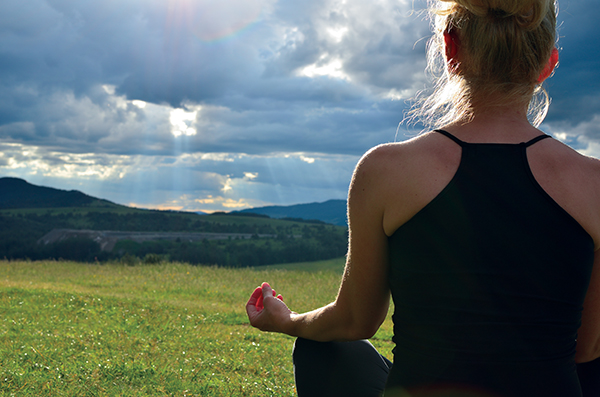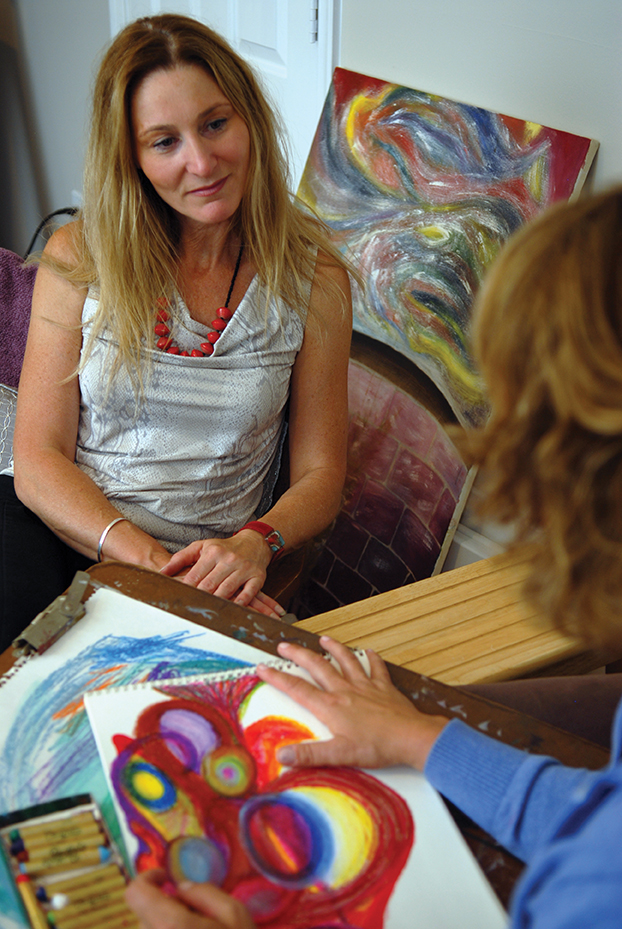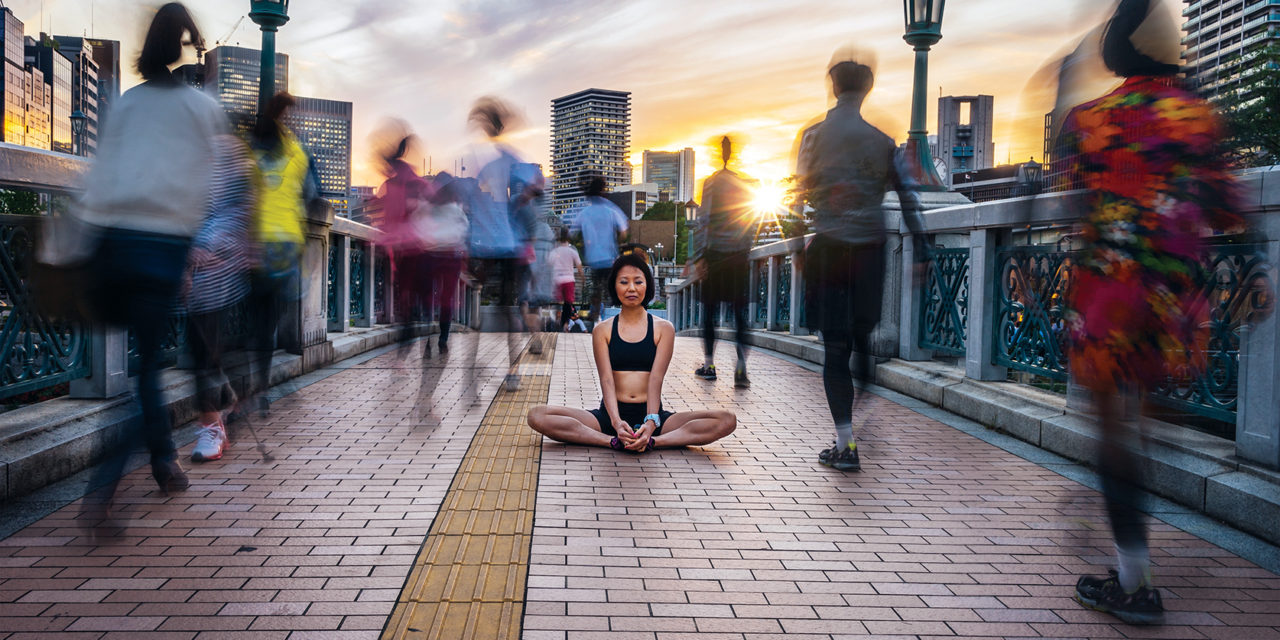Anxiety can keep us from being present and content in our lives. Since there’s no one-size-fits-all approach to overcoming it, Real Woman turned to experts in the fields of psychology and medicine for the most current and practical advice for finding our happy place.
I don’t think people realize how common generalized anxiety disorder is, and it’s twice as common in women as it is in men. I see it so often now, and I think it’s because we have so many stressors today—so many demands on us.

How Common Are Anxiety Disorders?
In any given year, the estimated percentage of U.S. adults with these anxiety disorders are:
- 7 to 9 percent: specific phobia
- 7 percent: social anxiety disorder
- 2 to 3 percent: panic disorder
- 2 percent: agoraphobia
- 2 percent: generalized anxiety disorder
- 1 to 2 percent: separation anxiety disorder
It’s a pounding heart and cold sweats waking you up out of a dead sleep in the middle of the night. It’s tingling or shaking hands during a morning meeting. It’s a throat-tightening sense of the walls closing in. It’s a chronic headache. It’s back pain that can’t be explained by an MRI.
It’s a nagging dread, a pit in your stomach, and jittery, unnerving agitation.
Panic. Stress. Worry. Fear. Anxiety. We tend to use these words interchangeably in a society that has so many of us running 100 miles an hour to keep up with our careers and our loved ones, to grapple with challenges, to stay healthy and fit, and to remain engaged and educated about what’s happening in our rapidly changing world. But for people who suffer from debilitating anxiety disorders, these words have distinct meanings and life-altering implications. For them, tasks as simple as driving to work or taking a shower can result in a loop of general unease, tension, and full-throttle terror that can come on gradually, or hit without warning like a Midwestern tornado. Sometimes anxiety is intertwined with depression, and other times it rides alone. It may follow a pattern, or it may completely reinvent itself. But it’s always disruptive and often paralyzing.
So how do we get rid of it—and should that even be the goal? Advances in psychiatry and medicine have led to a more significant and effective arsenal for treating crippling anxiety in the last half century, but anxiety is still the most common mental disorder, affecting nearly 30 percent of adults (40 million in the U.S.) at some point in their lives. Disorders range from generalized anxiety disorder (GAD)—which affects 6.8 million American adults, or somewhere between 2 and 3 percent of the population—to social anxieties and phobias.
The hallmark of most anxiety disorders is an inability to control worry. But this state of mind can lead to an array of uncomfortable and even painful symptoms and habits, from night sweats to chronic fatigue and feeling generally keyed up. “It’s a mind, brain, and body issue. Imagine your mind as a TV: anxiety can feel like you’re rapidly changing channels, or, alternatively, like you’re stuck on the same channel,” says Bo Forbes, clinical psychologist, yoga and mindfulness teacher, and author of Yoga for Emotional Balance. “We have this idea that things that feel good are good, and things that don’t feel good are bad and shouldn’t be happening. Anxiety is often seen as something terrible because it doesn’t feel good. But anxiety is elemental and organic. It’s an inherent part of life. Rather than trying to remove it from our environment, we can cultivate a relationship with it and build resilience.”
However, while anxiety may be a practical (and even useful) tool for the body and mind, it’s also one of the most common reasons people seek out medical advice as they face uneasy sensations or physical symptoms that keep them from being productive or present in their lives. “Eleven years into my practice, I see far more patients for mental health, and specifically GAD, than I did when I first started practicing. It’s now one of my top two or three diagnoses,” says Jill Young, DO, Capital Health Primary Care – Quakerbridge. “I don’t think people realize how common it is, and it’s twice as common in women as it is in men. I see it so often now, and I think it’s because we have so many stressors today—so many demands on us.”

Anxiety is often seen as something terrible because it doesn’t feel good. But anxiety is an inherent part of life. Rather than trying to remove it from our environment, we can cultivate a relationship with it and build resilience.
Understanding Anxiety
Many people who suffer from generalized anxiety disorder or other anxiety-related disorders have decreased levels of serotonin, a neurotransmitter which is thought to regulate anxiety, happiness, and mood, says Young. While some people confuse it with stress, “GAD is characterized by excessive or persistent worrying that causes significant stress or impairment in more days than not,” she says. “People who come in for treatment have often been dealing with it for more than 6 months. In fact, people can often relate it back to their childhood.”
There are two main hallmarks for a person to be diagnosed with an anxiety disorder, says Young. First, the anxiety must be out of proportion to the situation or be age-inappropriate. This is an important distinction, she says, because if a person is under severe distress, like coping with the death of a loved one, for example, it can cause similar symptoms and emotional discomfort as an anxiety disorder. The second element is that an anxiety disorder will hinder a person’s ability to function normally. Anxiety disorders can cause people to try to avoid situations that trigger or worsen their symptoms. That can mean the total upheaval of their lives, including personal relationships, job performance, fitness and health, and overall wellbeing.
But even with both of those pieces in play, an anxiety disorder can be a diagnosis of exclusion or the piecing together of a puzzle made up of a constellation of physical, mental, and emotional symptoms, says Young. The trick with diagnosing GAD or many other anxiety-related disorders is understanding that they can present with a variety of physical symptoms (or be the cause of them), which can be troubling for the patient and make a clinical diagnosis somewhat difficult to determine. “People can present generalized anxiety disorder with irritability or increased muscle tension or headaches,” says Young. “The constellation of symptoms can be pretty vast.”
The problem for doctors is that the reverse can also be true. In an article called “Managing Anxiety in the Medically Ill,” Psychiatric Times recently published a “partial listing” of 47 medical illnesses, ranging from cardiac arrhythmias to pancreatic cancer, that may first present as anxiety. The article was meant to alert medical professionals that some patients seeking treatment for anxiety or depression may have an underlying medical condition that may be causing the anxiety. Young says it’s up to the doctor to get as much information from the patient as possible. “Sometimes, as his or her doctor, you have to dig a little deeper to see if there’s anxiety or if something else is going on,” says Young. “I think a lot of it is about taking a good history and asking the right questions, such as do they find themselves worrying about things more than they have in the past.”
Color Me Happy
Not only does anxiety present itself differently from one person to the next, finding an effective treatment can be individually customized. The most common pharmacological options are a class of drugs known as selective serotonin reuptake inhibitors (SSRIs), also known as antidepressants, such as Zoloft, Wellbutrin, Paxil, Prozac, Lexapro, and Celexa, which address the decreased level of serotonin in the brain. “For people with anxiety disorders, there is a true chemical imbalance,” she says.
But it often takes some trial and error—mixed with lifestyle changes—for patients to yield the best results. While drugs can help mitigate symptoms of anxiety, Young encourages patients to do things that, quite simply, make them happy. “Exercise naturally increases your serotonin levels, so that’s a great place to start,” she says. “I also recommend patients get outside and experience nature—vitamin D and sunlight impact people’s moods in a positive way. Being near water or even the mountains has a calming effect on people. Whether it’s yoga, meditation, prayer, support groups, or just being with friends, doing what feels good to you will help you manage your anxiety, especially during the more difficult moments.”
For many people, treating anxiety is a journey, and finding the most effective salves—whether it’s acupuncture, kickboxing, hiking, reading, or a little of everything—depends on the individual. The act of creating art, recognized in recent years for its therapeutic characteristics, not only explains the adult coloring craze, but it is also gaining momentum and respect as a legitimate option for people suffering from anxiety, depression, and even post-traumatic stress disorder. “I try to help people recognize they have anxiety and figure out what the triggers are,” says Tara Bane, who recently opened Blue Sky Therapy Center, an art therapy practice in Newtown, Pa. “A lot of people don’t even know what their triggers are, and it can be a simple shift once they identify those. People often recognize that they’re not functioning well, but they might not be able to see the totality of it because they’ve lived with the discomfort for a long time and they’ve become accustomed to it.
“If people come in talking about how their anxiety is affecting so many parts of their lives, I’ll have them draw what their anxiety looks like.”
In many cases, just visualizing what a person’s life would look like without the anxiety is an effective tool to getting to that place, Bane says. She used these techniques to help her cope with her own grief and trauma after losing her husband on 9/11. “The act of creating something taps into your nervous system and soothes your nerves,” she explains. “It’s a powerful thing.”
But Bo Forbes says there’s also power in the anxiety itself, as long as we are present and embodied. “For a long time, we all grew up thinking that stress is bad, but it’s actually the belief that stress is bad that can hurt us. The goal is to become fluent in working with states of our own discomfort rather than trying to remove them,” says Forbes. “We become more resilient and flexible about dealing with states of discomfort, rather than making them go away. Working with our own discomfort helps wire optimal patterns in the mind, brain, and body, whether or not someone chooses to take medication.” Helping people build up emotional resilience and self-awareness is one of her main goals, and she encourages and teaches a variety of restorative yogic techniques and deep breathing to achieve it. In a world when we’re so often moving at hyper speed, Forbes suggests slowing things down.
“I’ve been practicing as a psychologist and yoga teacher for 27 years, and I’ve found that it actually doesn’t take much to reset the nervous system. It’s about being willing to slow things down, which is not a mindset we’ve had in the past,” Forbes says. “For example, practicing yoga that resembles tai chi, rather than one that resembles an intense workout, can be helpful. Exercise is great, too. But when it comes to rewiring the mind, subtle practices—moving slowly in asana and bringing awareness to the inner body—is hugely helpful.”
And, perhaps more difficult for many of us who move at breakneck speed to maintain our lives, Forbes suggests slowing things down more broadly—walking at a more leisurely pace, eating slower, and reducing multisensory overload. “It’s important to listen to what the body is telling you. It may be hard to hear, but we don’t always want to alleviate anxiety—sometimes we just want to experience it and stay in our bodies. Being present in our bodies is also known as interoception, or mindfulness in the body,” she says, “and this, in itself, has a healing impact on anxiety.”
These six symptoms are most commonly associated with anxiety
- Restlessness or feeling on edge
- Fatigue
- Difficulty concentrating
- Irritability
- Muscle tension
- Sleep disturbance

Tara Bane recently opened Blue Sky Therapy, which uses art therapy to help patients with anxiety and other disorders.







It is quite difficult but not impossible.